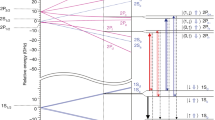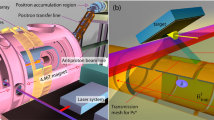Abstract
Atoms made of a particle and an antiparticle are unstable, usually surviving less than a microsecond. Antihydrogen, made entirely of antiparticles, is believed to be stable, and it is this longevity that holds the promise of precision studies of matter–antimatter symmetry. We have recently demonstrated trapping of antihydrogen atoms by releasing them after a confinement time of 172 ms. A critical question for future studies is: how long can anti-atoms be trapped? Here, we report the observation of anti-atom confinement for 1,000 s, extending our earlier results by nearly four orders of magnitude. Our calculations indicate that most of the trapped anti-atoms reach the ground state. Further, we report the first measurement of the energy distribution of trapped antihydrogen, which, coupled with detailed comparisons with simulations, provides a key tool for the systematic investigation of trapping dynamics. These advances open up a range of experimental possibilities, including precision studies of charge–parity–time reversal symmetry and cooling to temperatures where gravitational effects could become apparent.
This is a preview of subscription content, access via your institution
Access options
Subscribe to this journal
Receive 12 print issues and online access
$209.00 per year
only $17.42 per issue
Buy this article
- Purchase on Springer Link
- Instant access to full article PDF
Prices may be subject to local taxes which are calculated during checkout




Similar content being viewed by others
References
Pohl, R. et al. The size of the proton. Nature 466, 213–216 (2010).
Fee, M. S. et al. Measurement of the positronium 13S1–23S1 interval by continuous-wave two-photon excitation. Phys. Rev. Lett. 70, 1397–1400 (1993).
Yamazaki, T. et al. Formation of long-lived gas-phase antiprotonic helium atoms and quenching by H2 . Nature 361, 238–240 (1993).
Nakamura, K. et al. (Particle Data Group). Review of particle physics. J. Phys. G 37, 075021 (2010).
Lüders, G. Proof of the TCP theorem. Ann. Phys. 2, 1–15 (1957).
Baur, G. et al. Production of antihydrogen. Phys. Lett. B 368, 251–258 (1996).
Amoretti, M. et al. Production and detection of cold antihydrogen atoms. Nature 419, 456–459 (2002).
Gabrielse, G. et al. Background-free observation of cold antihydrogen with field-ionization analysis of its states. Phys. Rev. Lett. 89, 213401 (2002).
Hänsch, T. W. & Zimmermann, C. Laser spectroscopy of hydrogen and antihydrogen. Hyperfine Interact. 76, 47–57 (1993).
Fujiwara, M. C. et al. Towards antihydrogen confinement with the ALPHA antihydrogen trap. Hyperfine Interact. 172, 81–89 (2006).
Setija, I. D. et al. Optical cooling of atomic hydrogen in a magnetic trap. Phys. Rev. Lett. 70, 2257–2260 (1993).
Eikema, K. S. E., Walz, J. & Hänsch, T. W. Continuous coherent Lyman-α excitation of atomic hydrogen. Phys. Rev. Lett. 86, 5679–5682 (2001).
Kielpinski, D. Laser cooling of atoms and molecules with ultrafast pulses. Phys. Rev. A 73, 063407 (2006).
Shlyapnikov, G. V., Walraven, J. T. & Surkov, E. L. Antihydrogen at sub-Kelvin temperatures. Hyperfine Interact. 76, 31–46 (1993).
Surkov, E. L., Walraven, J. T. M. & Shlyapnikov, G. V. Collisionless motion of neutral particles in magnetostatic traps. Phys. Rev. A 49, 4778–4786 (1994).
Andresen, G. B. et al. Trapped antihydrogen. Nature 468, 673–676 (2010).
Migdall, A. L., Prodan, J. V. & Phillips, W. D. First observation of magnetically trapped neutral atoms. Phys. Rev. Lett. 54, 2596–2599 (1985).
Helmerson, K., Martin, A. & Pritchard, D. E. Laser and rf spectroscopy of magnetically trapped neutral atoms. J. Opt. Soc. Am. B 9, 483–492 (1992).
Willems, P. A. & Libbrecht, K. G. Creating long-lived neutral-atom traps in a cryogenic environment. Phys. Rev. A 51, 1403–1406 (1995).
Hess, H. et al. Magnetic trapping of spin-polarized atomic hydrogen. Phys. Rev. Lett. 59, 672–675 (1987).
Bowman, J. D. & Penttila, S. I. On the measurement of the neutron lifetime using ultracold neutrons in a vacuum quadrupole trap. J. Res. Natl Inst. Stand. Technol. 110, 361–366 (2005).
Choi, J-H. et al. Magnetic trapping of long-lived cold Rydberg atoms. Phys. Rev. Lett. 95, 243001 (2005).
Andresen, G. B. et al. Evaporative cooling of antiprotons to cryogenic temperatures. Phys. Rev. Lett. 105, 013003 (2010).
Andresen, G. B. et al. Autoresonant excitation of antiproton plasmas. Phys. Rev. Lett. 106, 025002 (2011).
Bertsche, W. et al. A magnetic trap for antihydrogen confinement. Nucl. Instrum. Methods A 566, 746–756 (2006).
Andresen, G. B. et al. Antimatter plasmas in a multipole trap for antihydrogen. Phys. Rev. Lett. 98, 023402 (2007).
Gabrielse, G. et al. First capture of antiprotons in a Penning trap: A kiloelectronvolt source. Phys. Rev. Lett. 57, 2504–2507 (1986).
Huang, X-P. et al. Steady-state confinement of non-neutral plasmas by rotating electric fields. Phys. Rev. Lett. 78, 875–878 (1997).
Andresen, G. B. et al. Compression of antiproton clouds for antihydrogen trapping. Phys. Rev. Lett. 100, 203401 (2008).
Surko, C. M. & Greaves, R. G. Emerging science and technology of antimatter plasmas and trap-based beams. Phys. Plasmas 11, 2333–2348 (2004).
Jørgensen, L. V. et al. New source of dense, cryogenic positron plasmas. Phys. Rev. Lett. 95, 025002 (2005).
Andresen, G. B. et al. Antihydrogen formation dynamics in a multipolar neutral anti-atom trap. Phys. Lett. B 685, 141–145 (2010).
Fujiwara, M. C. et al. Three-dimensional annihilation imaging of trapped antiprotons. Phys. Rev. Lett. 92, 065005 (2004).
Fujiwara, M. C. et al. Particle physics aspects of antihydrogen studies with ALPHA at CERN. AIP Conf. Proc. 1037, 208–220 (2008).
Fujiwara, M. C. Detecting antihydrogen: The challenges and the applications. AIP Conf. Proc. 793, 111–121 (2005).
Andresen, G. B. et al. Search for trapped antihydrogen. Phys. Lett. B 695, 95–104 (2011).
Gabrielse, G. et al. Antihydrogen production within a Penning–Ioffe trap. Phys. Rev. Lett. 100, 113001 (2008).
Robicheaux, F. Atomic processes in antihydrogen experiments: A theoretical and computational perspective. J. Phys. B 41, 192001 (2008).
Pohl, T., Sadeghpour, H. R. & Gabrielse, G. New interpretations of measured antihydrogen velocities and field ionization spectra. Phys. Rev. Lett. 97, 143401 (2006).
Gabrielse, G. et al. Driven production of cold antihydrogen and the first measured distribution of antihydrogen states. Phys. Rev. Lett. 89, 233401 (2002).
Glinsky, M. E. & O’Neil, T. M. Guiding center atoms: Three-body recombination in a strongly magnetized plasma. Phys. Fluids B 3, 1279–1293 (1991).
Fujiwara, M. C. et al. Temporally controlled modulation of antihydrogen production and the temperature scaling of antiproton–positron recombination. Phys. Rev. Lett. 101, 053401 (2008).
Gabrielse, G. et al. First measurement of the velocity of slow antihydrogen atoms. Phys. Rev. Lett. 93, 073401 (2004).
Madsen, N. et al. Spatial distribution of cold antihydrogen formation. Phys. Rev. Lett. 94, 033403 (2005).
Robicheaux, F. et al. Simulations of antihydrogen formation. Phys. Rev. A 70, 022510 (2004).
Strasburger, K., Chojnacki, H. & Skolowska, A. Adiabatic potentials for the interaction of atomic antihydrogen with He and He+. J. Phys. B 38, 3091–3105 (2005).
Armour, E. A. G. et al. The interaction of antihydrogen with simple atoms and molecules. Nucl. Instrum. Methods B 266, 363–368 (2008).
Gregory, M. R. & Armour, E. A. G. Hydrogen molecule–antihydrogen scattering at very low energies. Nucl. Instrum. Methods B 266, 374–378 (2008).
Cohen, J. S. Molecular effects on antiproton capture by H2 and the states of –p formed. Phys. Rev. A 56, 3583–3596 (1997).
Topçu, T. & Robicheaux, F. Radiative cascade of highly excited hydrogen atoms in strong magnetic fields. Phys. Rev. A 73, 043405 (2006).
Taylor, C. L., Zhang, J & Robicheaux, F. Cooling of Rydberg during radiative cascade. J. Phys. B 39, 4945–4959 (2006).
Pohl, T., Sadeghpour, H. R., Nagata, Y. & Yamazaki, Y. Cooling by spontaneous decay of highly excited antihydrogen atoms in magnetic traps. Phys. Rev. Lett. 97, 213001 (2006).
Acknowledgements
This work was supported in part by CNPq, FINEP/RENAFAE (Brazil), NSERC, NRC/TRIUMF, AIF, FQRNT (Canada), FNU (Denmark), ISF (Israel), MEXT (Japan), VR (Sweden), EPSRC, the Royal Society and the Leverhulme Trust (UK) and DOE, NSF (USA). We are grateful to the AD team for the delivery of a high-quality antiproton beam.
Author information
Authors and Affiliations
Consortia
Contributions
All authors contributed significantly to this work.
Corresponding authors
Ethics declarations
Competing interests
The author declare no competing financial interests.
Additional information
A full list of authors appears at the end of this paper.
Rights and permissions
About this article
Cite this article
The ALPHA Collaboration. Confinement of antihydrogen for 1,000 seconds. Nature Phys 7, 558–564 (2011). https://doi.org/10.1038/nphys2025
Received:
Accepted:
Published:
Issue Date:
DOI: https://doi.org/10.1038/nphys2025
This article is cited by
-
The effect of negative mass in gravitating systems
Pramana (2023)
-
Primordial Black Holes from Collapsing Antimatter
Foundations of Science (2022)
-
From trapping to laser-cooling antihydrogen
Nature Reviews Physics (2021)
-
Four-body Calculation of Inelastic Scattering Cross Sections of Positronium–Antihydrogen Collision
Few-Body Systems (2021)
-
Laser cooling of antihydrogen atoms
Nature (2021)



